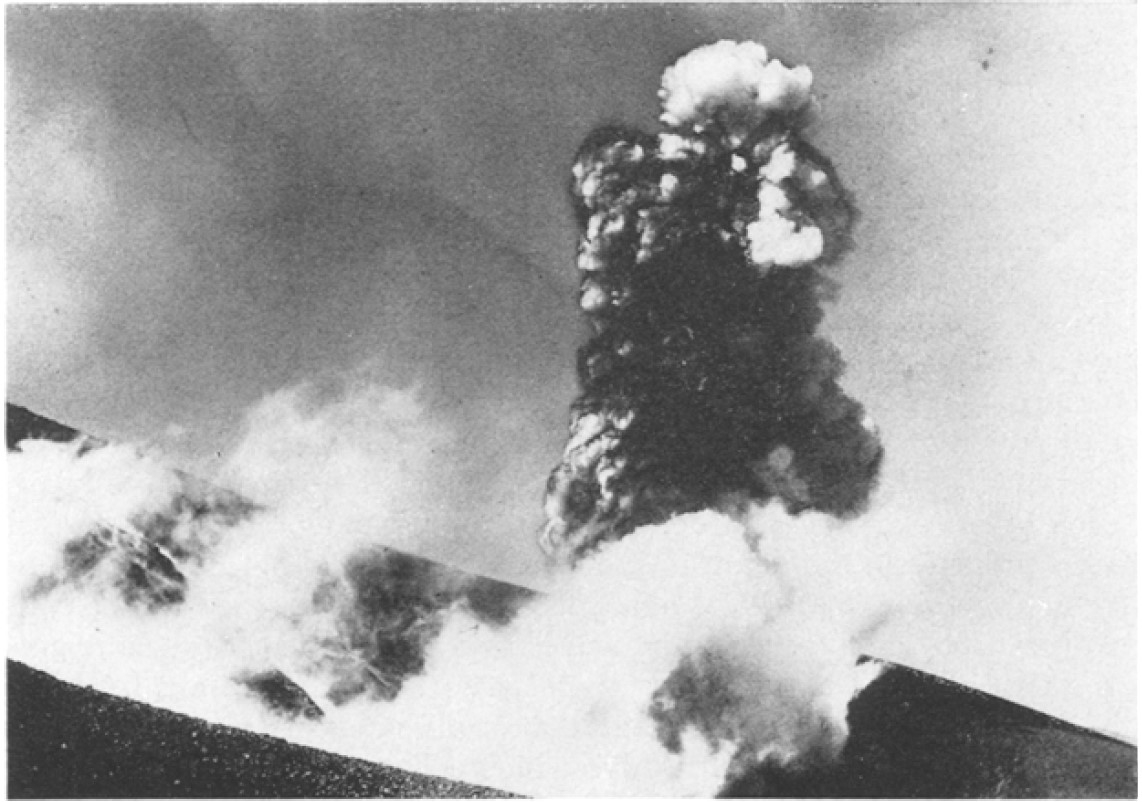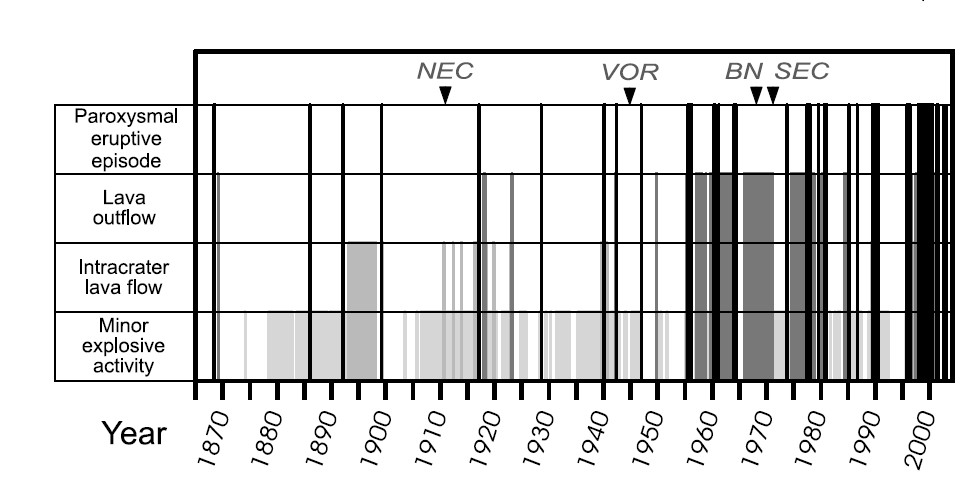
18 May 1971. This date may not mean anything to you at the moment, but it represents a very special day for the evolution of Mount Etna, leaving a deep mark in the recent eruptive activity of the volcano.
Exactly 50 years ago, Mount Etna saw the birth of what, only a short time later, was to become the most active crater of the last decades: “The South-East Crater”, the fourth child of Mama Etna! You will undoubtedly have heard about him this year!
Indeed, since February, the South-East Crater (shortly SEC) has given us an incredible series of spectacular lava fountains, giant tongues of fire touching the sky of Catania accompanied by huge ash columns which extend vertically for more than 10’000 meters! Maybe he was impatient to celebrate his birthday and has started the fireworks display early? Who knows? But the eruptive series was absolutely mesmerizing, and widely filmed and photographed, making it possible for everyone to enjoy it, even for those who live far away from the European Colossus, “Mt. Etna”.
Today we would like to celebrate the 50th anniversary of the SEC’s birth by walking through its past and recent activity!
Let’s start from the beginning… Where is Mount Etna? And how does it look like?

Figure 1 – Map of Etna, showing the spatial distribution of eruptive fissures (in dark gray) produced by the flank eruptions occurring from 1610 to 2012. The dashed black line delineates the area of 1170 km2 containing the 500 m spaced grid of potential vents. (a) Rose diagram representing the geometric orientation of the eruptive fissures; (b) frequency of the eruptive fissures during the last four centuries (the last column on right cumulates the fissures opened in the period 1900–2012). Image from Cappello et al., 2013.
Mt. Etna is located on the eastern Sicily in Italy, and with its more than 3300 m of elevation and a covering area of about 1250 km2, winning its title of “largest volcano in Europe” (Figure 1). Mt. Etna is also one of the most active volcanoes worldwide producing a wide range of eruptive activity every year, from effusive activity up to violent explosive eruptions. All these characteristics make its the undisputed Queen of Volcanoes in Europe.
It has a very long history starting around 600’000 years ago, but the main stratovolcano we can observe now only started its formation about 60’000 years ago with the building of the volcano Ellittico, as a result of the stabilization of the feeding system. Moreover, most of the edifice we can observe now was formed during the current phase, named Mongibello, which started around 15’000 years ago (Behncke and Neri, 2003; Branca et al., 2004; Magee et al 2020).
Since the 17th century an almost complete catalogue of the eruptions exist, making it possible for a researcher to study the evolution of the volcano over the past 400 years (Behncke and Neri, 2003; Cappello et al., 2013).
Probably, 400 years may sound like a short time interval to observe important changes in the behaviour of a mature volcano, and this observation might be true for many volcanoes worldwide, but talking about Etna, well, you might be wrong…
Indeed, in this last 400 hundred years, our European Queen presented a very irregular eruptive behaviour, with many changes in almost everything: eruptive style, output rate, and eruption frequency. These features changed within both century and decade intervals (Cappello et al., 2013). In the last decades the number of explosive events experienced a strong increase, mainly in the summit area, which went through drastic morphological modifications (Behncke and Neri, 2003; Cappello et al., 2013; Cappello et al., 2019).
How many summit craters are currently active on Mama Etna?
As already mentioned before, Etna is a mature stratovolcano (or composite volcano), built in thousand years by the overlay of layers and layers of lavas and tephra, with a central main eruptive area. This type of volcano is supposed to have a persistent activity at the summit crater, and a permanent shift in the main eruptive vent may be expected to occur only after important structural variations, in a large time window (Acocella et al., 2019; Cappello et al., 2019). For that reason, it is rare to document a shift in the eruptive vent in mature volcanoes.
…but we are talking about Mama Etna, and on its mesmerizing landscapes, everything is possible!
The summit area of Mt. Etna was composed for many centuries by one, main central crater, also named as The Central Crater! In the last decades an increase in the number of vents was observed in the summit area. In an only 60 years’ time span the number of active craters switched from one to four!
The activity firstly shifted in the newborn North East Crater in 1911, and only 34 years later Mama Etna gave birth to Voragine (1945), raising the erupting mouths to two. Then we have the formation of Bocca Nuova in 1968, and finally, on 18 May 1971, The South East Crater (SEC), the youngest and the most active carter of Etna (Behncke et al., 2006; Del Negro et al., 2013; Acocella et al., 2016). Figure 2 shows an aerial view of the different craters of Mama Etna.

Figure 2 – 2015 DEM of the summit area of Mount Etna, with outlines of the areas affected by recent lava covers. from Neri et al., 2017
That’s it? Was it the only vent shift in recent times…?
Of course, the answer is “no!”, Another important shift in the vent location occurred in mid-May 2007, where the activity of the South East Crater migrated eastward at a new vent, formed at the SE base of SEC. This new crater rapidly grew his own cone, which was morphologically distinguishable from the old edifice SEC (Acocella et al., 2016; Cappello et al., 2019; Di Renzo et al., 2019). This new cone took the name of New South-East Crater (NSEC, as seen in figure 2) and maintained this name until December 2020. Indeed, over the last few years, the gradual and continuous growth of the NSEC cone has generated a progressive coalescence with the SEC cone, leading to the loss of a clear morphological difference between the two cones, and the resulting SEC-NSEC apparatus can be now defined as the Southeast Crater again (INGV-OE, bollettini multidisciplinari).
If you are interested in learning more on why a mature volcano does need new vents and on the impact of a vent shift on the volcanic hazard, I strongly recommend you read Acocella et al., 2016 and Cappello et al., 2019.
Which is the activity of South East Crater?

Figure 3 – A violent emission of gasses, charged with ash, sand and stony material from the explosion funnel formed at the eastern base of the terminal cone, the 18th of May 1971. This picture captures the beginning of a new eruptive adventure, “The South East Crater Era”. Image from Rittmann et al., 1973

Figure 4 – Eruptive activity at the summit at monthly intervals, 1866–2003. The frequency of paroxysmal eruptive episodes shows a distinct increase since 1960. The dates of birth of each of the four present summit craters are indicated by arrows (BN, Bocca Nuova; NEC, Northeast Crater; SEC, Southeast Crater; VOR, Voragine). modified from Behncke and Neri 2003.
The main activity of SEC crater consists in strombolian activities, lava fountaining, ash emissions, and production of lava outflows of trachybasalt products. Its formation marks a drastic change in the eruptive frequency of Mt. Etna, during its first 41 years of life, SEC produced over double of the eruptions produced by both the Central Crater and the North East Crater in 110 years (Cappello et al., 2013) Taking only into account the fountaining activity, from 1971 to 2018 the crater produced more than 200 episodes (Cappello et al., 2019)!
This very high frequency activity is unique in the recent past of Mt. Etna, as underlined by Cappello et al., 2013, if we want to find periods in the history of the volcano of similar intensity, we should go back several hundred years in the past, a period in which the historical records were less accurate than today.
The new vent began its activity with a steam jet that ejected lithic and juvenile material (Figure 3, and figure 5a). The first strombolian activity began in 1978 from a new vent, nearby the previous one (Figure 5b). In the same year, on November 25 the first lava fountain also occurred, yielded by a new vent located in the South-Western corner inside the SEC (Calvari et al., 1994).

Figure 5 – Pictures of South-East crater (Mt. Etna, Italy) from 1971 to 2000. The picture (a) was shot by Carmelo Sturiale; the pictures(b) and (c) by Giuseppe Scarpinati; the pictures (d) and (f) by the INGV cameras on the summit area, and finally picture (f) was shot by Boris Behncke. All the pictures are taken from: http://www.italysvolcanoes.com.
This first, historical lava fountain marked the beginning of hundreds of similar episodes…
…episodes that the youngest vent is still producing now.
The succession of numerous fountaining events, lava flows, and strombolian explosions are responsible of the significant morphological modification that the SEC cone underwent during its entire history, and as you will see his shape and hight is constantly changing in present day!
As seen in figure 5c, between 1989 and 1990 the cone grew rapidly (Andronico and Corsaro, 2011). A significant acceleration in the growth of the cone occurred between 1996 and 2001 (Figure 5 d and f), where lava fountains played a main role, causing SEC to gain ~105 m in height (Figure 5f).
Between 26 January and 24 June 2000, there were 64 lava fountains – 33 of which occurred between the 1st and the 20th of February. That means more than one paroxysm per day, in an extremely periodical series of fountains. After this period, the height of the cone increased by ~40 m (Alparone et al., 2003; Andronico and Corsaro, 2011).
If this growth rate sounds high to you, then you’ll be amazed to hear that between January 2011 and April 2012, the NSEC produced 25 lava fountains. If we sum the duration of each episode, we obtain a cumulative duration of 51h of continuous fountaining a window of time in which NSEC grew more than 190 m (Behncke et al., 2014)!
What about the last Eruption?

Figure 6 – picture of the 22-23 April 2021 paroxysm, from Giorgio Costa (Link).
The most recent series of paroxysmal eruptions starts at South East Crater between the 13th and the 14th of December. After this event, other two episodes occurred on the 21st and the 22nd of December and one on the 18th of January (INGV-OE bollettini multidisciplinari; INGVvulcani).
The drastic change in the activity occurred in February, where a series of 17 paroxysmal events occurred between the 16th of February and the 31st of March, with an almost perfect rhythm of an eruption every 2 days! The events have been really powerful, and characterized by huge fire fountains, that in some cases have been reached more than 1000 m tall (!!!), accompanied by ash columns which often approaches the subplinian column dimensions (INGV-OE bollettini multidisciplinari; INGVvulcani). This series was really amazing to follow online, and we strongly recommend you take a look at the live videos of the eruptions performed by LocalTeam, they really did a nice work (link),
During this series of events more vents opened, aligned in the same east-west line on the SEC summit, producing huge lava fountains. As you can easily imagine… when all these vents were contemporary active, Etna offered us a priceless show of a fan of lava fountains. One of the most beautiful examples of this activity was the one produced on the 20th of February, where 6-7 vents were contemporary erupting, all aligned in a row.
If you are looking for the most iconic eruption of the whole period, I certainly recommend you take a look at the one occurred in the night between the 22 and the 23 of February. Where the fire fountain exceeds 1’500 meters in height (INGVvulcani, The Guardian).
To better figure it out the dimension of this fire fountain, you might visualize 1’500 meters as almost 5 Eiffel Tower stacked on top of each other. And yes, you might agree with me that this looks pretty impressive!
Finally, the last eruption of the series, between the 31st of March and 1st of April saw the birth of some small erupting vents at the southern base of the SEC cone.
In this wonderful picture posted by Boris Behncke on Twitter (account that I highly recommend you follow for all the interesting post on the Etna volcanic activity and the high quality volcanological contents), we can see the strong modification the SEC cone underwent in this very recent and short span of time!
We are at the end of this adventure thorough the SEC history, I hope you enjoyed the reading, today is the 5th of May, only 13 days far from the Etna Birthday… who knows… maybe Etna has a birthday show in store for us.
Reference
- Acocella, V., Neri, M., Behncke, B., Bonforte, A., Del Negro, C., & Ganci, G. (2016). Why does a mature volcano need new vents? The case of the New Southeast Crater at Etna. Frontiers in Earth Science, 4, 67.
- Alparone S., AndronicoD., Lodato L. and Sgroi T., (2003) Relationship between tremor and volcanic activity during the Southeast Crater eruption on Mount Etna in early 2000. Journal of Geophysical Research, vol. 108, NO. B5, 2241.
- Andronico D., Corsaro R.A. (2011) Lava fountains during the episodic eruptions of South East Crater (Mt. Etna), 2000: insights into magma-gas dynamics within the shallow volcano plumbing system. Bulletin of Volcanology (2011) 73:1165-1178.
- Behncke, B., & Neri, M. (2003). Cycles and trends in the recent eruptive behaviour of Mount Etna (Italy). Canadian Journal of Earth Sciences, 40(10), 1405-1411.
- BehnckeB., Neri M., Pecora E., Zanon V. (2006) The exeptional activity and growth of the Southeast Crater, Mount Etna (Italy), between 1996 and 2001. Bulletin of Volcanology (2006) 69: 149-173.
- Behncke, B., Branca, S., Corsaro, R. A., De Beni, E., Miraglia, L., & Proietti, C. (2014). The 2011–2012 summit activity of Mount Etna: Birth, growth and products of the new SE crater. Journal of Volcanology and GeothermalResearch, 270, 10-21.
- Branca S., Coltelli M., Groppelli G., (2004) Geological Evolution of Etna Volcano. Mt. Etna: Volcano Laboratory. Geophysical Monograph Series 143.
- Calvari S., Coltelli M., Müller W., Pompilio M., Scribano V. (1994) Eruptive history of South-Eastern Crater of Mount Etna, from 1971 to 1994. ActaVulcanologia – Vol.5 – 1994: 11-14.
- Cappello, A., Bilotta, G., Neri, M., & Negro, C. D. (2013). Probabilistic modeling of future volcanic eruptions at Mount Etna. Journal of Geophysical Research: Solid Earth, 118(5), 1925-1935.
- Cappello, A., Ganci, G., Bilotta, G., Corradino, C., Hérault, A., & Del Negro, C. (2019). Changing eruptive styles at the south-east crater of Mount Etna: Implications for assessing lava flow hazards. Frontiers in Earth Science, 7, 213.
- Del Negro, C., Cappello, A., Neri, M., Bilotta, G., Hérault, A., & Ganci, G. (2013). Lava flow hazards at Mount Etna: constraints imposed by eruptive history and numerical simulations. Scientific reports, 3(1), 1-8.
- Di Renzo, V., Corsaro, R. A., Miraglia, L., Pompilio, M., & Civetta, L. (2019). Long and short-term magma differentiation at Mt. Etna as revealed by Sr-Nd isotopes and geochemical data. Earth-Science Reviews, 190, 112-130.
- Magee, R., Ubide, T., & Kahl, M. (2020). The lead-up to Mount Etna’s most destructive historic eruption (1669). Cryptic recharge recorded in clinopyroxene. Journal of Petrology, 61(1), egaa025.
- Neri, M., De Maio, M., Crepaldi, S., Suozzi, E., Lavy, M., Marchionatti, F., … & Buongiorno, M. F. (2017). Topographic maps of Mount Etna’s summit craters, updated to December 2015. Journal of maps, 13(2), 674-683.
- Rittmann, A., Romano, R., & Sturiale, C. (1973). Some considerations on the 1971 Etna eruption and on the tectonophysics of the Mediterranean area. Geologische Rundschau, 62(2), 418-430.
Links
- INGV-OE, bollettini multidisciplinari: https://www.ct.ingv.it/index.php/monitoraggio-e-sorveglianza/prodotti-del-monitoraggio/bollettini-settimanali-multidisciplinari
- INGVvulcani Blog: https://ingvvulcani.com/
- LocalTeam Youtube Channel: https://www.youtube.com/channel/UCb06zgE7f5ItdRI5WEXT1AQ
- The Guardian, Etna Eruption Article: https://www.theguardian.com/world/2021/feb/23/mount-etna-lava-fountain-explosion-volcano-europe-active
- Boris Bhencke Twitter Account: https://twitter.com/etnaboris
- Giorgio Costa Instagram Page: https://www.instagram.com/gio_2898/?hl=it



Pingback: Geochemistry, Mineralogy, Petrology & Volcanology | Volcanoes and Wines, Part 2
Pingback: Geochemistry, Mineralogy, Petrology & Volcanology | Volcanoes and Corals: a journey to discover volcanic activity as seen from a coral perspective with Prof. Thomas Sheldrake
Pingback: Geochemistry, Mineralogy, Petrology & Volcanology | Volcanoes and Corals: a journey to discover volcanic activity as seen from a coral perspective with Prof. Tom Sheldrake